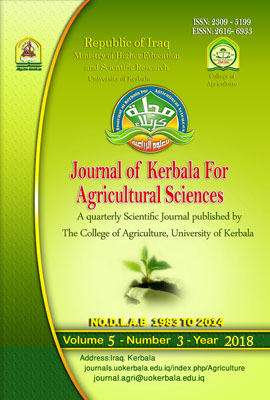Effect of hornwort extract and magnetically treated water on some growth chemical and production of cucumber cucumis sativus l. In desert area
DOI:
https://doi.org/10.59658/jkas.v5i3.517Keywords:
Cucumber, hornwort extractions , the magnetized waterAbstract
Field experiment was conducted in An-Najaf governorate during of 2016 in two season spring and autumn. The aim of this experiment was to study the effect of hornwort extractions and magnetically treated water on growth and yield parameters in cucumber plant beta alfa variety
The experiment included nine treatments, i.e. the interactions of three concentrations of hornwort extractions (first factor)(0, 10 and 20ml.L-1)sprayed on vegetative and magnetically treated water(second factor) (0, 1000 and 2000 gauss).Sprays were applied third, first sprayed through four true leaves stages, second flowering initiation, third after two weeks from second sprayed.
Split-Plot Design with in Randomized Complete Block Design (R. C. B. D.) was used with three replications. magnetically treated water treatments was distributed in main plots and hornwort extractions treatments in sub plot , Means were compared according to Duncan's Multiple Range Test (D.M.R.T.) at probability of 0.05.
Results can be summarized as follows:.
1- Using of concentrations of hornwort extractions had a significant effect on measured vegetative growth parameters (plant length, leaves number). There was no significant effect between 10 and 20ml.L-1in plant length parameter. There was no significant effect between1000 and 2000 gauss in plant length for two season and leaves number in spring cultivation. interaction between factors gave the same trends on vegetative growth parameters.
2- Using of concentrations of hornwort extractions had a significant effect on fruit growth parameters 20ml.L-1treatment gave the highest means for the fruit length and total yield (53.08 and 39.55ton.h-1) compared with control gave the lowest means for the measured parameters for both season. There was no significant effect between 10 and 20ml.L-1 in fruit length parameter in spring cultivation,2000 gauss treatment gave the highest means in total yield(48.51 ton.h-1) in spring cultivation while1000 gauss treatment gave the highest means in total yield(35.70 ton.h-1) in autumn cultivation, 1000 and 2000 gauss don’t gave a significant effect in total yield for both season.1000 and 2000 gauss don’t gave a significant effect in fruit length for both season.
3-Spraying of hornwort extraction as conc. 20ml.L-1 had a significant effect on measured chemical parameters such, total chlorophyll for both season, respectively, while proline in leaves which gave the least values with the use of hornwort extraction.
Irrigation with 2000 gauss treatment gave the highest means for the, total chlorophyll for both season, while proline in leaves which gave the least values with the use of magnetically treated water. There was no significant effect between 1000 and 2000 gauss in total chlorophyll content for both season and proline in leaves in the Spring cultivation.
Downloads
Published
How to Cite
Issue
Section
License
Copyright (c) 2018 Copyright (c) 2024 is the Author's article. Published by the Journal of Kerbala for Agricultural Sciences under a CC BY 4.0 license

This work is licensed under a Creative Commons Attribution 4.0 International License.
Licensing Terms
All articles are published under a Creative Commons License and will be directed to the Creative Commons Attribution 4.0 International License (CC BY 4.0) That permits use, distribution, and reproduction in any medium, provided the original work is properly cited. This license also allows the work to be used for commercial purposes.
Use by both non-commercial and commercial users
This content is licensed under a Creative Commons Attribution 4.0 International (CC BY 4.0) license, permitting use by both non-commercial and commercial users. Individual users may access, download, copy, display, and redistribute the articles to colleagues, as well as adapt, translate, and text- and data-mine the content, subject to the following conditions:
- The author's moral rights, including the right of attribution and the right to protect their work from derogatory treatment, are respected.
- Where content in the article is identified as belonging to a third party, users must ensure that any reuse complies with the copyright policies of the owner of that content.
- If the article content is reused for research or educational purposes, users should maintain a link to the appropriate bibliographic citation, including the DOI and a link to the published version on the journal's website.






